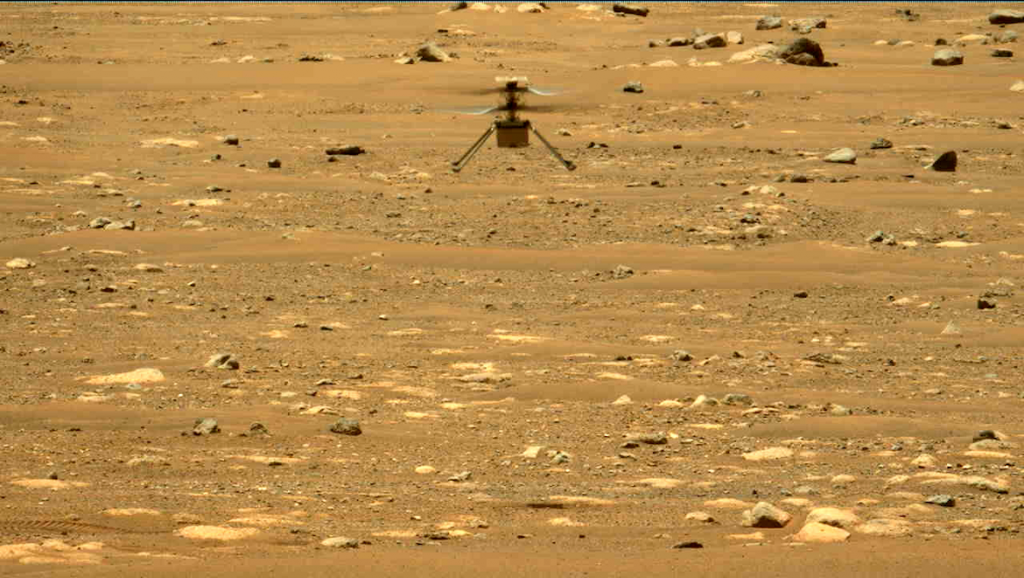
NASA has confirmed that its groundbreaking Mars helicopter Ingenuity has successfully completed its fifth test flight, and revealed the first audio clip taken of the rotorcraft buzzing through Martian skies.
According to NASA, its Perseverance rover on Mars was able to use its SuperCam microphone to record the first ever audio clip of an aircraft in flight on another planet, during Ingenuity’s fourth test flight.
The rover was parked around 80 metres from Ingenuity’s take-off and landing spot, and mission control was unsure if the noise of the rotorcraft’s blades, which spin at 2,537 rpm, would be audible over the sounds of the Martian gusty atmosphere.
However, scientists were able to isolate the sound of Ingenuity, to better hear the hum of Ingenuity above the winds.
Listen here:
Much to NASA’s delight, Ingenuity again performed exactly as planned for its fifth flight, as it conducted its very first one-way trip to a brand new patch of Martian soil.
The rotorcraft took off from Wright Brothers Field, an airfield that now sits in Jezero Crater, before it travelled 129 metres south, retracing its route from test flight four.
It then soared to a new record height of 10 metres to scope out its new surroundings, and take additional photos of the area around and below it, before landing. The flight lasted a total of 108 seconds.
Ingenuity’s newest landing zone was chosen specifically by NASA based on information previously recorded from Ingenuity’s test flights.
Through information provided by Ingenuity, NASA was able to generate digital elevation maps indicating almost completely flat terrain with almost no obstructions.
According to NASA, the fifth test flight marks the transition into Ingenuity’s new operations demonstration phase.
This next phase will focus on investigating what kind of capabilities rotorcraft operating from Mars can provide, such as scouting, aerial observations, access to areas inaccessible by a rover, and detailed stereo imaging from atmospheric altitudes.
“These operations and the lessons learned from them could significantly benefit future aerial exploration of Mars and other worlds,” NASA said.
Currently, Ingenuity sits in its new airfield, and awaits new instruction from NASA mission control, sent via its companion, the Perseverance Rover.
The Mars rover carries Ingenuity’s communications base station, so while it’s important the two stay nearby, Ingenuity will now be travelling ahead of Perseverance, though keeping in the same direction.
Both now continue to head south, as Perseverance is shortly set to commence science operations and sample collections on a new region of Mars.
According to NASA, the near-term strategy for Perseverance doesn’t require long drives that would leave the helicopter far behind, allowing Ingenuity to continue with its operations demonstration.
“The plan forward is to fly Ingenuity in a manner that does not reduce the pace of Perseverance science operations,” said Bob Balaram, chief engineer for the Ingenuity program.
“We may get a couple more flights in over the next few weeks, and then the agency will evaluate how we’re doing. We have already been able to gather all the flight performance data that we originally came here to collect. Now, this new operations demo gives us an opportunity to further expand our knowledge of flying machines on other planets.”
“We bid adieu to our first Martian home, Wright Brothers Field, with grateful thanks for the support it provided to the historic first flights of a planetary rotorcraft,” Balaram added.
“The fifth flight of the Mars Helicopter is another great achievement for the agency,” said Bob Pearce, associate administrator for NASA’s Aeronautics Research Mission Directorate. “The continuing success of Ingenuity proves the value of bringing together the strengths of diverse skill sets from across the agency to create the future, like flying an aircraft on another planet!”












